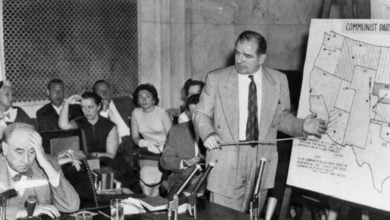All of a sudden, “fake news” has become the topic du jour in the media. And while the fake news that The Onion has been publishing for years is always good for a laugh, other fake news can have actual consequences. This week a deluded individual, having read a reportedly widely-circulated story that Hillary Clinton and her campaign chief were running a child sex ring out of a pizza parlor in Washington, D.C. (!), went to the restaurant and opened fire with a rifle. Fortunately no one was hurt.
But “fake news” had become news long before this incident, primarily as the latest excuse for why Hillary Clinton lost the election, and, as we’ll discuss below, the latest way to implicate Russia in her loss. Figures were circulated about how such so-called fake news stories had been seen millions of times on the Internet, with the implication that the result was Clinton’s loss. Nevermind that no evidence has actually been presented, nor could it, proving this allegation. Nevermind that any such bizarre stories about Clinton were undoubtedly circulated by hard-core Trump supporters, whose Facebook friends or Twitter followers were likely to be mostly, if not entirely, other hard-core Trump supporters, whose opinions were hardly changed one way or the other by the fake stories. Nevermind that only utterly delusional individuals could believe the most bizarre of these stories (like the sex ring story).
And, to be clear, “fake news” stories are not exclusively targeted at Hillary Clinton, like the story circulated during the campaign that Trump had a secret server directly connected to a Russian bank. Just this week, a Facebook friend posted an article alleging that Sarah Palin had called for a boycott of the Mall of America over a Black Santa Claus because “Santa was always white in the Bible.” There is in fact racist criticism from some because of the Black Santa Claus, and Sarah Palin may (or may not) have voiced such criticism, but even she isn’t dumb enough (I hope!) to think that Santa Claus is mentioned in the Bible. Nor are these fake stories only about Presidential candidates. Another FB friend of mind recently posted an article that Cuban ballet great Alicia Alonso had died (fake news stories of Fidel’s death have been a staple over the years, but now that he has actually died, apparently perpetrators of such nonsense had to turn elsewhere).
But the thing about stories like this, as noted above, is that while they may be amusing, their power to actually influence people is probably minimal. The only people who would repost the Sarah Palin story, and the only people who would believe it, are the same people who already think (correctly!) that Sarah Palin is an idiot. Sarah Palin supporters certainly wouldn’t repost the article (unless they didn’t get the joke!), and if they saw it in the news feed of a liberal friend, they would just (rightly in this case) scoff. The “Fidel is dead” or “Alicia Alonso is dead” stories may have temporarily upset some people until they learned the truth, but their lasting effect is nil.
But the ginned up outrage over “fake news” has potential consequences way beyond the pizza parlor gunman, and it’s largely aimed at imperialism’s latest target, Russia, trying to make the U.S.-Russia split as wide as possible, or irrevocable, before Donald Trump takes office and (if his campaign rhetoric is to be believed, which is dubious) tries to bring the two countries closer together. Most notable of these was a front-page article that appeared recently in the Washington Post, under the headline “Russian propaganda effort helped spread ‘fake news’ during election, experts say.” And who were these “experts?” Most of the article is based on a website entitled “PropOrNot,” created just this year and thus having no track record, and allegedly consisting of an “independent team of computer scientists, statisticians, national security professionals, journalists, and political activists.” All entirely anonymous, if such a “team” exists at all.
This anonymous source promotes a list of 200 websites which are allegedly spreading “Russian propaganda,” using this word salad of “criteria:” “We have used a combination of manual and automated analysis, including analysis of content, timing, technical indicators, and other reporting, in order to initially identify (‘red-flag’) the following as Russian propaganda outlets. We then confirmed our initial assessment by applying whatever criteria we did not originally employ during the red-flag process, and we reevaluate our findings as needed.” Just what “content” they are looking at is unspecified (does arguing against regime change in Syria count, for example?), nor how they would determine that that content originated in Russia. And even if these were somehow objective criteria (they aren’t), there is no presentation of any actual data; you simply have to take the word of this anonymous website, that these 200 websites, among which are many long-established, well-known and reputable websites such as antiwar.com, truth-out.org, and truthdig.com, along with equally reputable but Russian sites such as rt.com and sputniknews.com, met their “criteria” and are “spreading Russian propaganda,” either deliberately or as “useful idiots” (a term from the Washington Post article). Well, I certainly wouldn’t take their word for it, nor should any reasonable person. The Washington Post, however, did.
And the consequences for those 200 websites? Here’s what PropOrNot says in their FAQ in answer to the question, “Is this McCarthyism?”: “We are not accusing anyone of lawbreaking, treason, or “being a member of the Communist Party” [my note: PropOrNot doesn’t seem to recognize that the Communist Party isn’t in power in Russia, which tells us something about their qualifications as “experts”]. However, when outlets and individuals echo Russian propaganda, we’re going to highlight it. We are also encouraging others to help us research this further, and we are calling for formal investigations by the US government, because the kind of folks who make propaganda for brutal authoritarian oligarchies are often involved in a wide range of bad business. We strongly suspect that some of the individuals involved have violated the Espionage Act, the Foreign Agent Registration Act, and other related laws, but determining that is up to the FBI and the DOJ.”
So they’re not saying people are guilty of treason, but they “strongly suspect” it and are encouraging the FBI and DOJ to investigate. This is a chilling attempt to stifle free speech, particularly the speech of those who oppose U.S. imperialism, and nothing more.
But having said a lot about the fake “fake news” controversy, it’s important to remember that the American public (and world opinion in general) is indeed subject to real “fake news” on a daily basis. The most prominent example that comes to mind was the abundance of fake news stories, promulgated by the most “reputable” of sources like The New York Times, which convinced the public that Iraq had weapons of mass destruction and that a U.S. invasion of that country was warranted. Some would argue that the “fake news” stories now in the news are different because the authors of those pieces know they are false and are just making up the news. But if Judith Miller and Michael Gordon didn’t know that the stories they were writing for the Times were false (and likewise for reporters for other media), they certainly knew that they were simply taking the word of their sources on the information, with no actual proof provided. And their sources certainly knew the information was false.
And the result of those stories? It wasn’t one armed man going into a pizza parlor and shooting a gun into the ceiling, it was 200,000 armed men and women invading a country and ultimately producing the death of over a million people, leaving in their wake wars and deaths that continue to this very day and show no signs of ending any time soon.
And long before Iraq was Vietnam, where the fake story known as the Gulf of Tonkin launched the Vietnam War, where hundreds of thousands of armed Americans invaded yet another country and killed another million people.
But we don’t have to go back to Iraq or Vietnam to find fake news in the media, and the fakery can be a lot subtler than outright lies. Consider events in the Middle East. Every American who pays any attention to the news knows about “Aleppo” (even if most of them couldn’t find it on a map). It’s the “greatest tragedy in the world today.” It’s a question asked of Presidential candidates, and it’s “what should we do about Aleppo?” (not “what right do we have to be intervening in Syria and trying to overthrow its government?” or even “should we do something about Aleppo?”)
Now contrast that with Yemen, where an equally deadly war is raging. Unlike the one in Syria, however, where mainly covert U.S. aid is involved, the one in Yemen involves U.S. bombs, U.S. planes (flown by Saudi pilots but refueled in the air by other U.S. planes flown by Americans), and Americans doing the targeting. Very much a U.S. war, in other words. How many Americans even know that war is going on, much less the extent of U.S. involvement in it? This is “fake news” by omission. The actual information may be available to news junkies who care to dig it out, but it certainly isn’t front and center (or anywhere) on the news most people see.
What are the consequences of this fake news? Not some alleged and utterly unprovable influence on the result of an election, but the very real continued use of U.S. weaponry and expertise to murder Yemenis.
The latest flap over Donald Trump taking a call from the President of Taiwan is another good recent case in point of “fake news by omission.” Viewers or readers of U.S. media all undoubtedly know that this was (allegedly) the first conversation between an American President (or President-elect) and Taiwanese President in decades; that was the headline that was all over the news, and the subject of endless conversation and condemnation of Trump by talking heads and op-ed columns in newspapers. The average news consumer might get the impression that Taiwan is persona non grata in the U.S. But nothing could be further from the truth. Just last December, President Obama approved the sale of $1.83 billion worth of weapons to Taiwan. That’s on top of another $9.15 billion back in 2011, and that’s just the weapons sales under Obama; there were many billions more under earlier Presidents.
But most people listening to or reading the news wouldn’t have learned these relevant facts which could put the significance of Trump’s phone call in perspective. The Washington Post article about the phone call didn’t mention arms sales at all, while The New York Times article contains only the briefest of passing mentions to “a well-established arms agreement grudgingly accepted by Beijing.” A follow-up article in the Times noted the $1.83 billion figure, but described it as “relatively modest.” And if broadcast media mentioned the arms sales at all, it was only because Donald Trump himself did, in a tweet, which seem to be required fodder for broadcast news.
Were the Post, the Times, and the other media making up the news like some of the “fake news” purveyors we’re urged to condemn? No. But did they tell “the truth, the whole truth, and nothing but the truth”? Absolutely not. And by not telling the whole truth, they were engaging in a deliberate attempt to bias their readers. Fake news by omission.
“Fake news” is a very real, daily phenomenon. But the perpetrator we need to worry about, the one which has a real impact on events and people’s lives, isn’t the Russian government or obscure conspiracy theorists. It’s the U.S. government, and the corporate media which spread its propaganda while posing as independent, unbiased sources. The importance of actually independent media like Liberation News and podcasts like Loud and Clear and By Any Means Necessary, media which tell the truth about what is happening in the United States and around the world, has never been greater.





